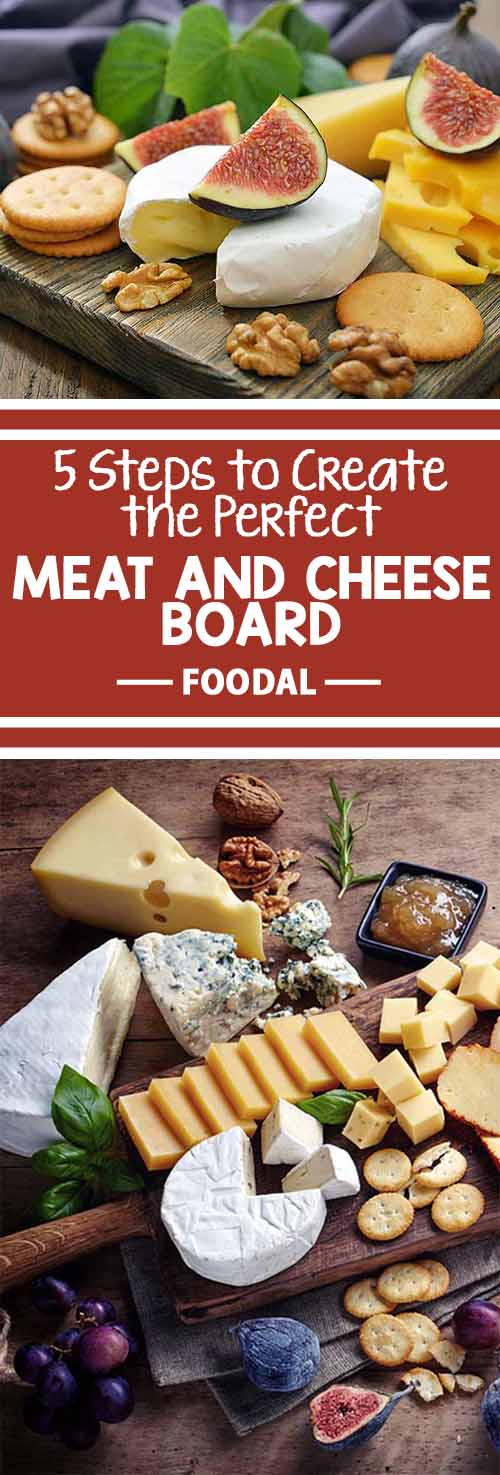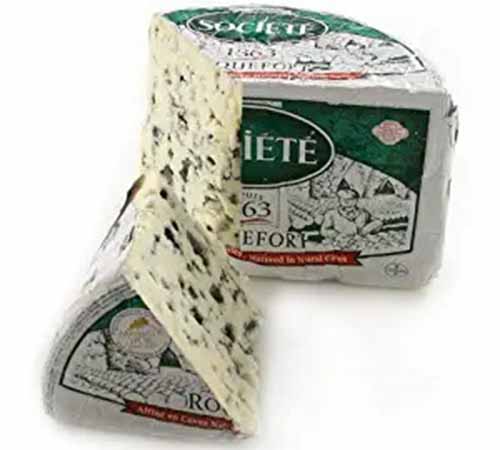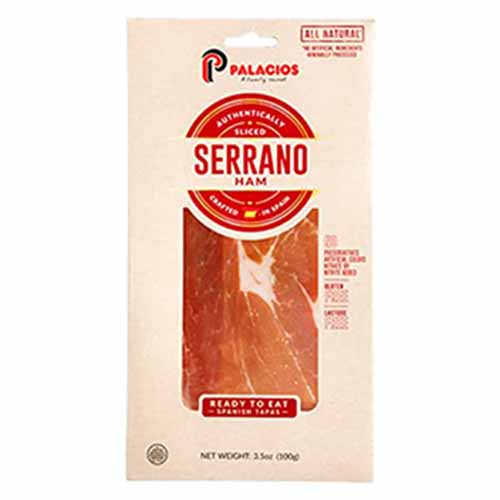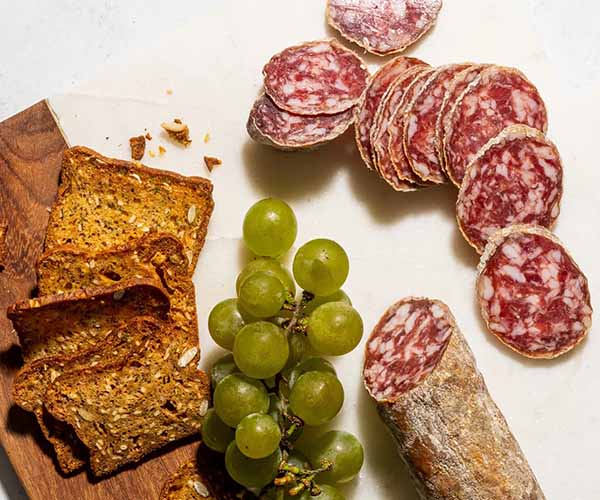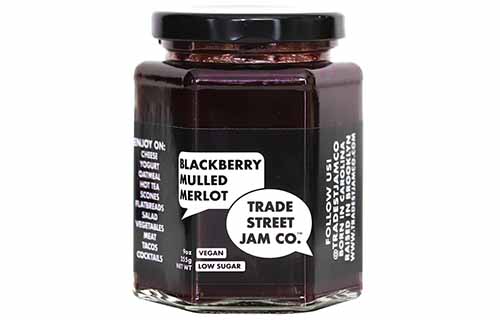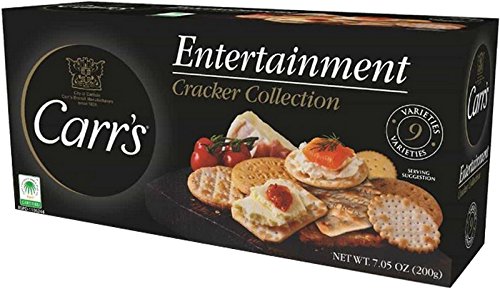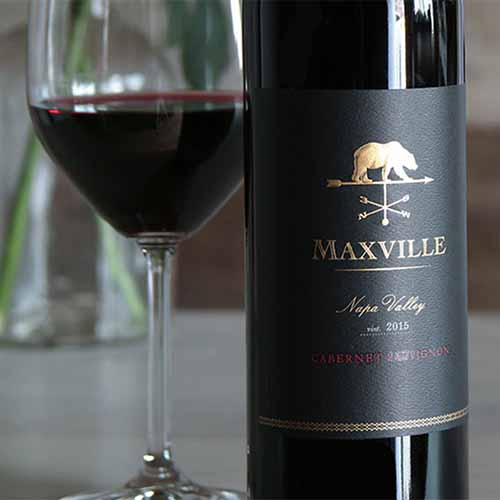We occasionally link to goods offered by vendors to help the reader find relevant products. Some of these may be affiliate based, meaning we earn small commissions (at no additional cost to you) if items are purchased. Here is more about what we do.
Glasses clinking, the soft hum of voices punctuated by laughter ringing out merrily, a bit of music playing in the background – this is the sound of happiness. Or at least it is in my book.
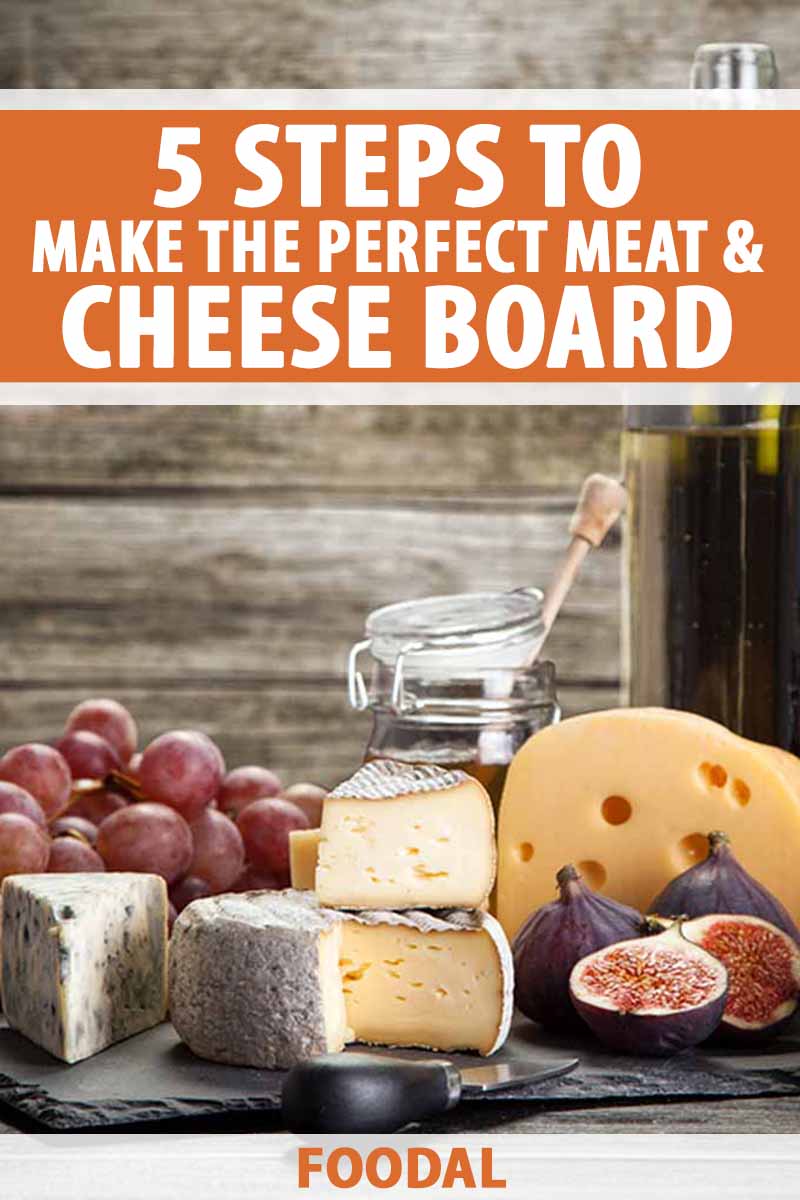
The sounds of people enjoying themselves as they dig into the food I’ve prepared always brings a smile to my face. I love to entertain!
Whether for holiday entertaining season or for a fun dinner party at the end of the week, you may be making plans to have guests over soon. I know some people get stressed out trying to plan everything, but hosting a gathering doesn’t have to be a headache.
Just because you’re entertaining doesn’t mean it has to be complicated or extravagant. A simple meat and cheese board paired with some good wine really goes a long way to creating an impressive and inviting spread of food.
If you’ve never put together a cheese board or a charcuterie (meat) spread, you may be wondering what exactly you will need.
Luckily, it’s pretty easy to put this appetizer or light meal together, especially if you follow these tips. Keep reading to learn how!
5 Steps to Create the Perfect Meat and Cheese Board
1. Make Your Main Event the Star of the Show
First things first: cheese is always the main attraction. Everything else that you serve is just there to complement or highlight the cheese, so make sure you get the good stuff.
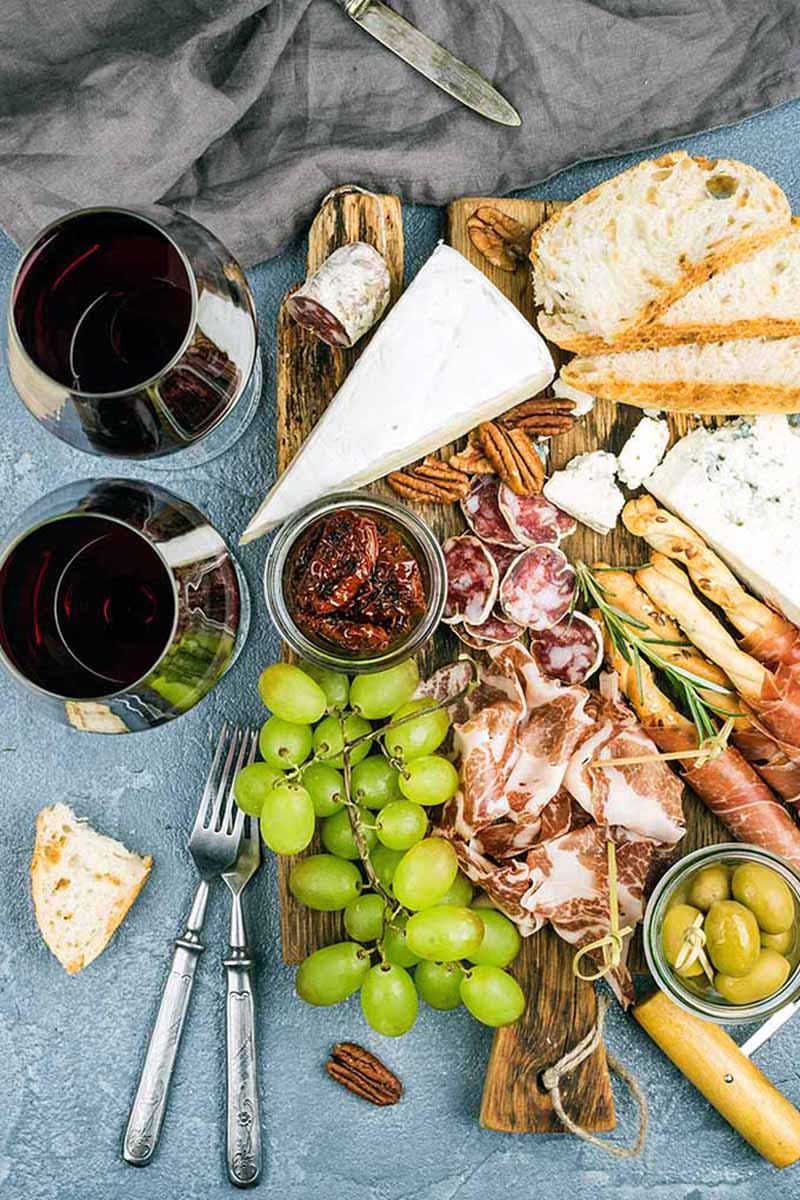
I highly recommend going to a high-end grocery store or even a specialty food store to purchase the dairy delights for your platter.
Not only will your local cheesemonger – or a grocery store like Whole Foods, with a dedicated staff in the specialty foods department – have a much wider selection from which to choose, they will also have knowledgeable people behind the counter who can answer any questions you may have, and help you make your selections.
How many kinds will you need? You don’t want to serve more than 3 or 4 different types, so as to avoid entirely overwhelming the palates of your guests.
As far as how much of each kind, about 2-3 ounces of each variety per person should be enough.
A general rule of thumb for a cheese board, and the best foundational guideline for beginners, is to have one hard, one soft, and one fresh cheese.
People who like blue cheeses will also include a blue. I am not one of those people, so I tend to leave that out of my presentation.
Now, I’m going to help you out even more, and give you a few examples for each category. If you find yourself overwhelmed by all the choices, keep things regional.
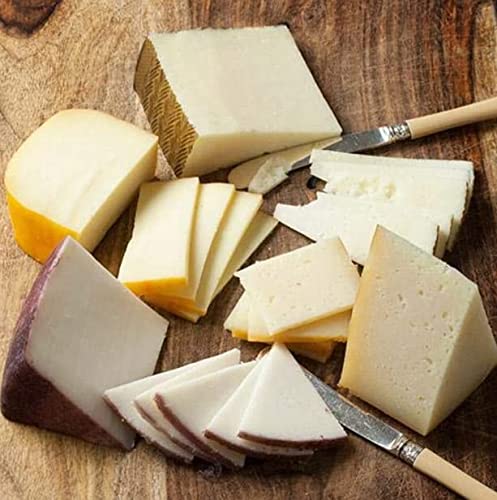
Spanish Cheese Assortment, available on Amazon
In other words, select a location-based theme. Say you choose Spain, for example. Pick one Spanish type from each category. This will help you to narrow down your choices. A regional selection like the one pictured above simplifies this process for you even further. This Spanish cheese collection is available on Amazon.
Hard
Hard cheeses are my favorite. The options are seemingly endless, especially when you get into the realm of aging. Aged varieties will have a sharper or tangier taste, giving a bolder, fuller flavor in your mouth.
Cheddar and gouda are two varieties that especially benefit from a longer aging process.
Parmesan is always aged, but parmesan that is aged longer than usual has a more distinctive flavor, especially if you buy the name-protected Parmigiano Reggiano which is aged for a minimum of 12 months.
Asiago
- Italian origin
- Semi-sweet
- Slightly nutty
- Faintly sharp
Cheddar
- American, English, or Irish origin
- Ranges from mild to very sharp
Gouda
- Dutch origin
- Buttery and nutty
- Slightly sweet but tangy at the same time
Gruyere
- Swiss origin
- Smooth and creamy mouthfeel
- Nutty and slightly salty
Manchego
- Spanish origin
- Made from sheep’s milk
- Mild and creamy
- Slightly tart
Parmesan
- Italian origin
- Nutty and salty
- The more aged varieties have a slightly grainy texture
Bloomy or Soft
With delightfully creamy and fudgy textures and flavors ranging from mild and milky to mushroomy and pungent, bloomy-rinded and soft-ripened varieties provide indulgent richness to the plate.
Brie
- French origin
- Typically a white rind
- Creamy mouthfeel
- Buttery, yet earthy flavor
Camembert
- French origin
- White rind
- Rich and buttery flavor
Taleggio
- Italian origin
- Thin, brownish rind
- Mild, fruity yet tangy flavor
A true fromage connoisseur would never even consider this, but for this category you could also include one of those spreadable herb and cheese blends. Or, you could make a cheese ball.
I LOVE cheese balls! But I grew up in the south, where cheese balls are served at every holiday gathering.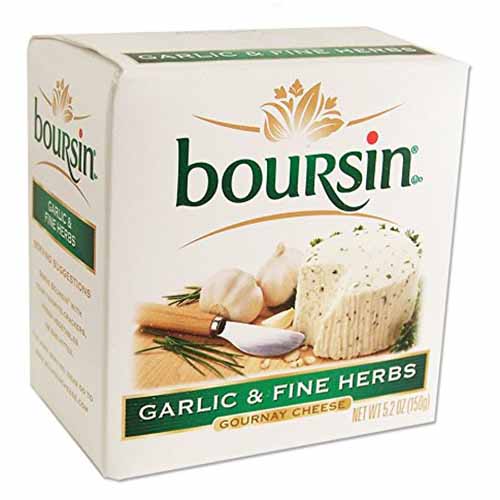
Boursin Cheese with Garlic and Fine Herbs, available on Amazon
Whatever you choose, the object of this category is to have a creamy, spreadable option that can be served on a cracker or crusty piece of bread.
Fresh
Aged for a limited length of time, fresh varieties provide saltiness and acidy like feta and fresh chevre, while others like delicate ricotta offer a moist and lactic choice.
These styles can provide necessary balance to more aged choices on a platter. Some of them are also perfect as the first layer to a composed crostini!
Feta
- Greek origin
- Salty and tangy flavor
Goat
- Range of origins
- Sharp and tangy flavor
Mozzarella
- Italian origin
- Mild and slightly sweet flavor
Ricotta
- Italian origin
- Sweet and creamy
- Similar to cottage cheese
Take a look at this article about fresh cheese varieties to discover even more options for this part of your platter.
Blue
Any cheese ripened with the mold Penicillium with have green, gray, blue, or black veins or spots of mold running through it. Bold and pungent, choose one of these when you know there are fellow blue cheese fans at the party.
Blue
- Range of American varieties
- Strong and tangy flavor
Gorgonzola
- Italian origin
- Sharp and earthy flavor
Gorgonzola Dolce
- Italian origin
- Buttery and slightly sweet
- Much milder than regular Gorgonzola
Roquefort
- French origin
- Made with sheep’s milk
- Very sharp flavor, but not super strong
Societe Roquefort, available on Amazon
Stilton
- English origin
- Very creamy with a complex, strong flavor
There are, of course, many more varieties available in each category. I have listed the options that are used most frequently, just to give you an idea of what falls under each category.
I encourage you to explore, and discover new taste sensations – learn about what’s unique to the region where you live, and feature a few unusual or unique options to add even more interest to your tasty spread.
Chances are you have at least one local cheese maker in your area, be it goat, sheep, or cow’s milk cheese. Do a little research, and see what you can find.
I love supporting local artisans, so don’t be afraid to try new things and at least sample your local offerings.
Remember, cheese tastes best at room temperature, so be sure to plate everything at least 30 minutes before guests arrive. You want those flavors to really pop!
2. Pick Some Great Secondary Flavor Sources
Now that we have the assiette a fromage all situated, let’s talk about the meat side of things.
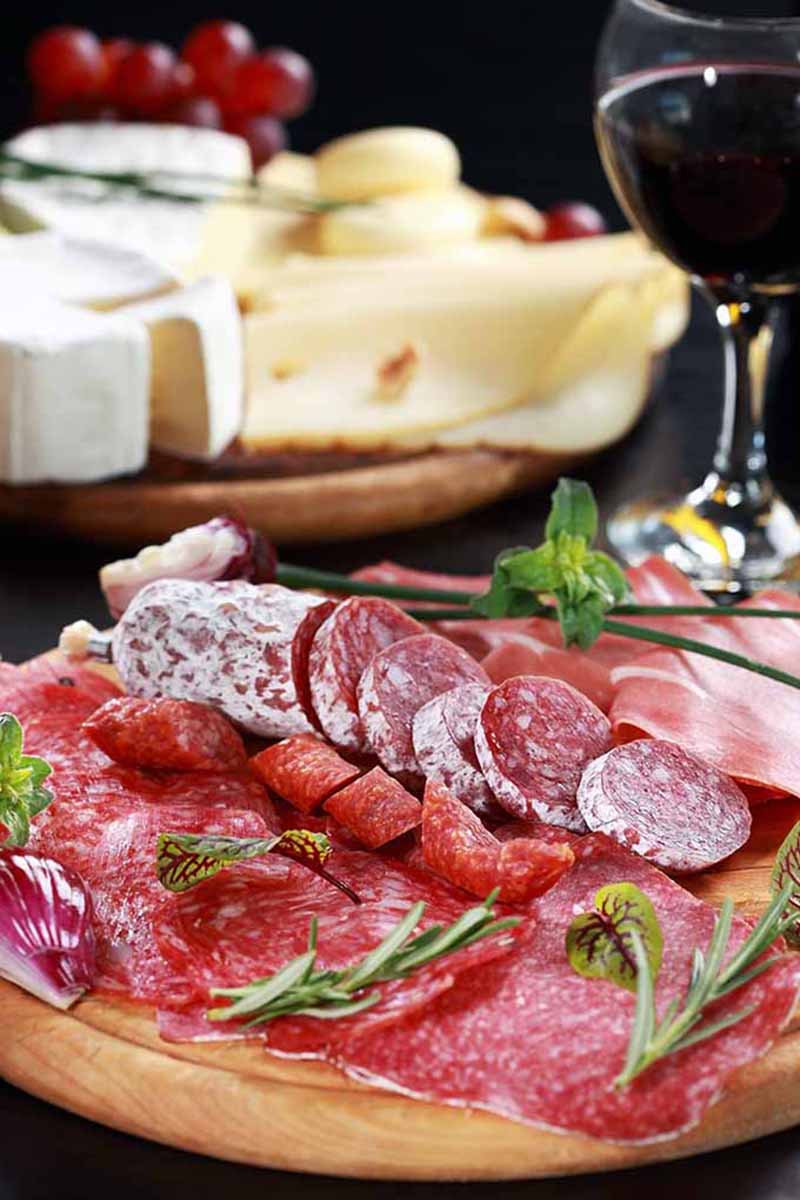
Since your cheddar and brie, or whatever you select, is the main event, you don’t need to go overboard on the meats.
This means you just need to pick one or two yummy options. If you were doing a full charcuterie platter, you would need more variety, but in this case it’s not necessary.

The Little Bit of Everything Collection from iGourmet, available on Amazon
For a meat and cheese charcuterie platter that’s all ready to go, try The Little Bit of Everything Collection from iGourmet. This selection of four cheeses, two meats, and other goodies like crackers, mustard, and olives is available on Amazon.
For the full charcuterie spread, you will typically see a cured meat, an encased meat (sausage), and often a pate. When combining the charcuterie with a cheese tray, you can limit this selection and just offer one or two different varieties.
I would recommend that you only offer one type of really smoky meat. Too much smoke flavor and soon all anyone will taste is the smoke.
Cured Meats
Thinly sliced cured meats look beautiful on a cheese board, like edible stained glass. From melt-in-your mouth Prosciutto di Parma to meatier Bresaola, one among this list will give you a filling accompaniment.
Bresaola
- Italian cured beef tenderloin
- Served thinly sliced
- This chewy meat tends to dry out
- Often served with a drizzle of olive oil to keep it moist
Jambon de Bayonne
- French country ham
- Originates from the city of Bayonne in southwestern France
- Similar in taste and appearance to Prosciutto di Parma
Jamon Iberico de Bellota
- High end, gourmet dry-cured Spanish ham
- Made from special black-hooved pigs
- These are fed only acorns during their last “bulking up” period
- This gives the ham a faintly sweet and nutty flavor that is really unique
- May also be aged for as long as five years, to give great depth of flavor
Jamon Serrano
- A more familiar Spanish ham, made from regular pigs
- Similar in texture to Jamon Iberico
- Has a rich, salty flavor
Sliced Jamon Serrano by Palacios, 3.5 oz., available via Amazon
Prosciutto di Parma
- Italian salt-cured ham
- Strong flavor and silky-smooth texture
- Served very thinly-sliced
Speck
- Italian dry-cured and smoked ham
- Similar to bacon in flavor
- Served thinly sliced, so it looks more like Prosciutto
Encased Meats (a.k.a. Sausages)
With these choices, you can buy them in a few different formats: pre-sliced and pre-packaged, whole chubs, or sliced fresh at the deli counter.
It’s an easy convenience to buy them sliced, but you are guaranteed paramount freshness when you buy the whole chub and slice them soon before serving.
Capicola
- Italian smoked pork cold cut (salume)
- Cured in a natural casing
- Mild, smoky flavor
- Notes of garlic, pepper, and other spices
- Served thinly-sliced
Chorizo
- Dry-cured Spanish sausage
- Not the raw Mexican chorizo – this is a dried meat that looks more like salami
- Strongly flavored and colored with paprika, like its Mexican cousin
- Depending on the type of paprika used, can range from spicy to slightly sweet
- Serve sliced into rounds or cubed
Mortadella
- Italy’s more sophisticated version of bologna
- Cooked, encased meat usually made with pork or beef
- Made with spices and nuts, usually black pepper and pistachios
- Has a much stronger flavor-profile than its American cousin
Salame Felino
- Cured Italian pork sausage from the town of Felino
- Made with salt, whole peppercorns, and white wine
- Aged slowly over a period of months
Salame Piccante
- Cured Italian pork sausage
- What Americans know as pepperoni
- Spicier than other salamis
- Made with peppers and a variety of spices, including paprika
Saucisson Sec
- French cured pork sausage
- Flavored with garlic and black pepper
- Similar in taste to Salame Piccante
Smoking Goose Rust Belt Saucisson, available from Mouth
Soppressata
- Italian dry-cured pork
- Flavor can vary greatly from region to region
- Southern soppressata is usually spicy, prepared with peppers
- Other areas have milder versions, bordering on sweet
- A popular alternative to pepperoni on pizzas
You also have the option to buy and cook raw or partially boiled sausages. For example, when Oktoberfest is right around the corner, offering a perfectly seared bratwurst with beer and a few alpine-style cheeses would be the perfect savory serving idea fit for the season!
Pates and Rillettes
What exactly is a pate? Basically, it’s a delicious spread of finely chopped or pureed seasoned meat.
Basically, this would be any kind of meat that is very finely minced and mixed with vegetables (like onion or garlic), truffles, nuts, and/or herbs and spices. The mixture then gets pureed to a smooth, creamy paste and is spread on bread, crackers, and the like.

Rougie Duck Rillettes du Perigord, available via Amazon
Most pates are made with chicken, duck, or goose liver, but I suppose you could make a pate out of any kind of meat, really.
A rillette is similar to a pate, most commonly made from salted pork that is finely chopped and cooked in fat, then made into a paste. Salmon rillette is popular as well.
The Rougie Duck Rillettes du Perigord products, available on Amazon, are made according to the Perigord tradition of SW France.
If you so desire, you can of course find a good recipe and make your own at home. However, the object here is to keep things simple.
There is nothing wrong with heading to the store and buying a premade pate. Lots of markets make their own, and they taste just as good as any you might make at home.
3. Make a Big Visual Impact with Accompaniments
Yes, you could just serve cheddar, Stilton, and mozzarella with some salami and Jamon Serrano on a piece of slate and call it a day, and it would be delicious. However, the presentation in that case might be a little on the boring side.
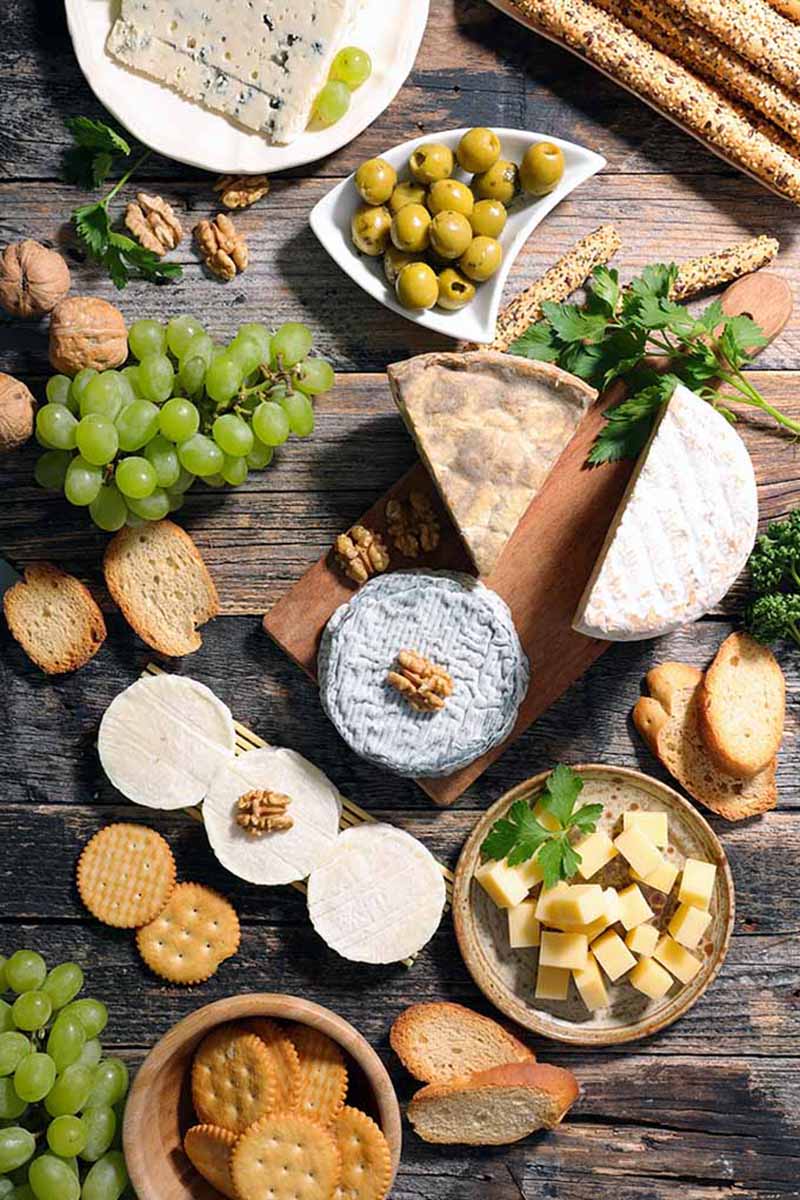
Jazz up your serving platters with some fruit, nuts, crackers and toast, chutney, fruit pastes, and jams to take the visual appeal up a notch. These serve as excellent companion pieces to the rest of the food, providing complementary or contrasting flavors while making your setup more aesthetically appealing.
Fruit
I think just about everyone knows that apple and cheddar is one of the best flavor combinations ever, but there are a myriad of other fruit options out there that pair well with a variety of cheeses.
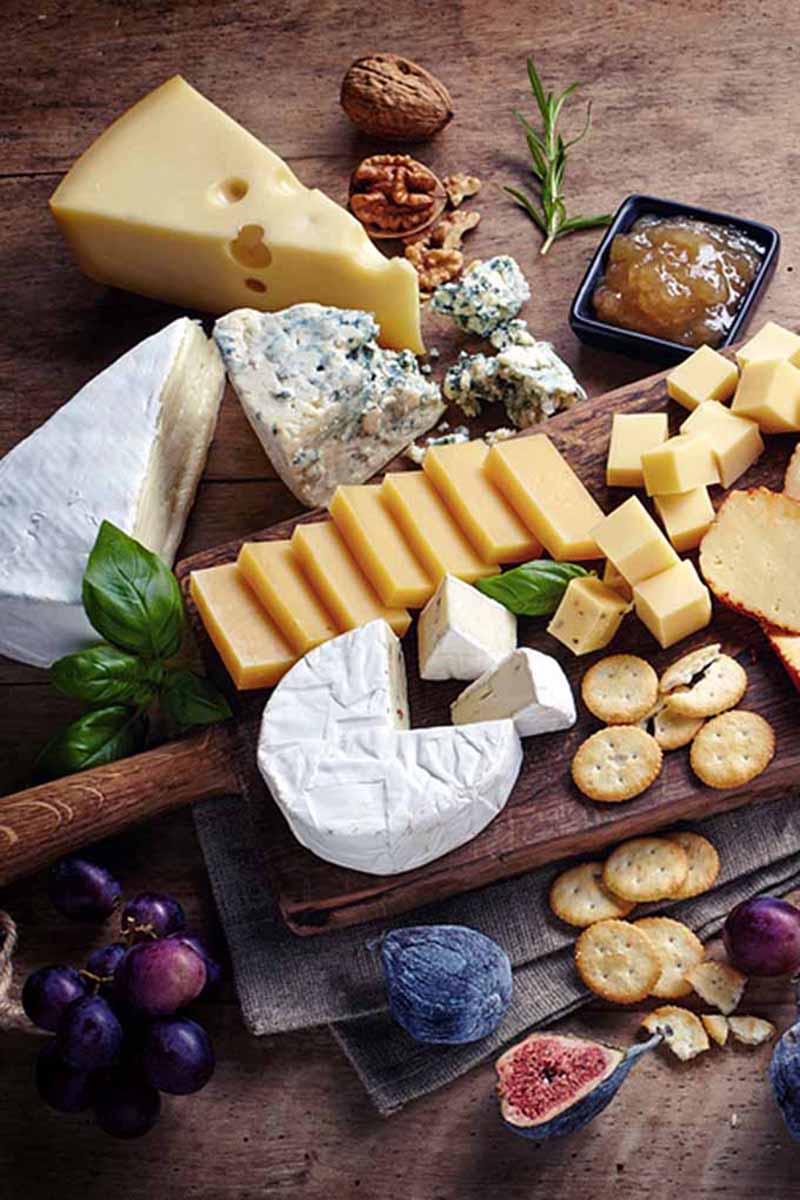
Some additional fruits you may want to consider are firm pears, grapes, figs, dried apricots, and prunes. You definitely do not want to pick any fruit with a bold flavor, or anything very juicy. This is to make serving simple, and to avoid drowning out the flavors of the more delicate cheese.
The one exception to this is melon.
Ripe cantaloupe or honeydew (or a mixture of the two, because the color combo is GORGEOUS) both taste amazing with prosciutto. If you’re planning to serve it, definitely buy some melon if it is in season, as well as a small melon baller.
Make a bunch of little melon balls and serve them in a separate bowl right beside the prosciutto, so people will know the two go together.
You could even serve them on the same platter, on skewers like a kabob, or with the prosciutto wrapped around the melon balls to make little heavenly bites.
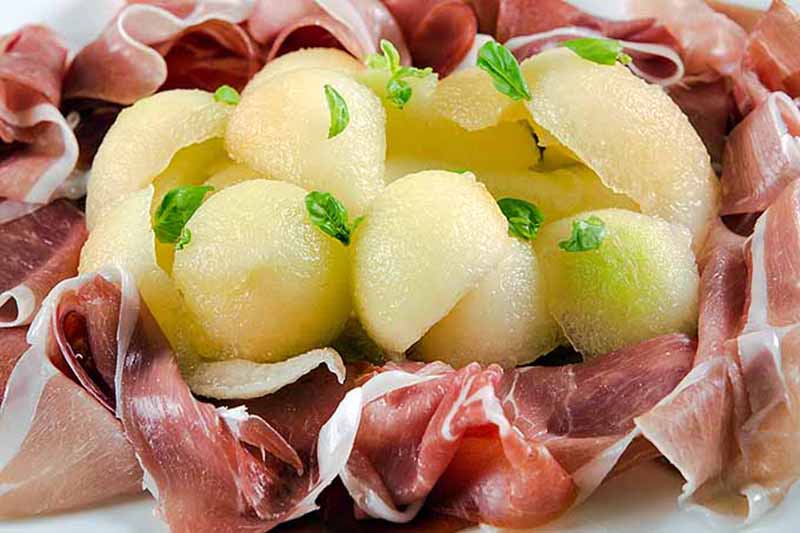
Pears have a mild sweetness that works with just about any cheese, so they’re right up there with apples as far as versatility goes. I especially love a slice of pear with a bit of warmed Brie on a plain cracker. Yum!
Grapes also have a milder flavor, so they pair with most anything, and keeping them on the bunch instead of picking them off to serve looks beautiful on the board next to the other food. What a pretty presentation!
Try snipping the stems to make palm-sized clusters so guests can serve themselves easily.
Figs are a stunning fruit that I think tends to be overlooked in North America. Figs and grapes are a great combo all on their own, but figs and cheese are fantastic together as well.
Fresh or dried (or even made into a paste), I would serve figs with brie or camembert, a sweet gorgonzola (the only blue cheese I will actually eat), or even a sharp cheddar.
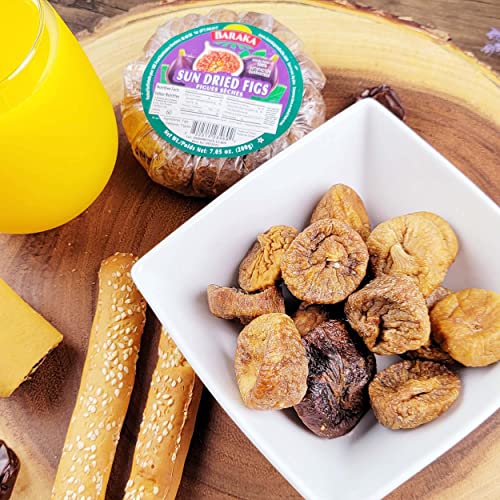
Baraka Dried Figs, available on Amazon
Dried fruits are great because they look like little jewels on the plate and offer a bit of sweetness with a nice chewy texture.
They aren’t messy at all, which is nice for finger foods, and their sweetness really cuts through the tanginess of sharp cheese, making it a great palate cleanser. If I had to choose just one, dried apricots are my favorite.
Jams, Spreads, and Other Sweet Trimmings
In addition to fresh or dried fruit, you have so many options to choose from in the preserved category.
If you choose a soft and mild ricotta or mascarpone, both of those go so well with a sweet garnish, like a red berry pudding or warm fruit compote.
For more of a dessert option, you can take a page from my mother’s holiday entertaining book. She likes to serve a brick of room temperature Neufchatel with a blueberry compote on gingersnaps. It is absolutely terrific and one of my favorite Christmas treats.
Trade Street Jam Co. Blackberry Mulled Merlot Jam, available from Mouth
Honey is also great with brie and other bloomy and soft varieties. Top a cracker spread with mascarpone with a drizzle of honey and a walnut half, and it’s like heaven in your mouth.
Pepper jelly is also tasty with brie or camembert, and would make a great appetizer spread on a cracker. Apricot preserves would be another good choice.
The condiment options are really endless, with fruit-based items like quince paste and various chutneys available. Just experiment and find what tastes good to you.
Nuts
Nuts are another addition that may serve as palate cleansers.
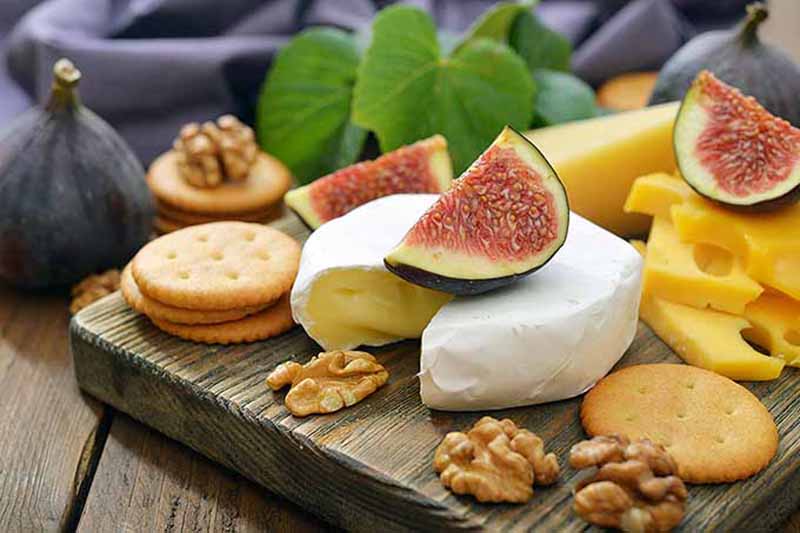
If you take a bite of salty parmesan and then you want to try a bit of brie, the leftover saltiness of the former will overwhelm the mild sweetness of the latter.
But, if you pop an almond in your mouth and eat that between the two, it will help you to be able to really appreciate the flavor of the Brie.
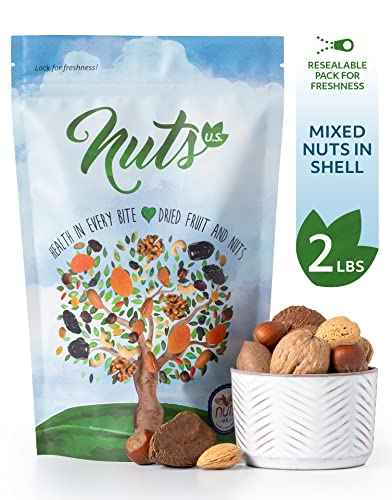
Nuts U.S. Mixed Nuts in Shell, available on Amazon
Pretty much any type of nuts can serve this purpose, preferably roasted and unsalted. I like to include some walnuts, pecans, or almonds. Those are all lower-priced nuts and also can all be found easily year-round.
To add a fun activity to the mix, purchase nuts that are still in their shells with a nutcracker and an empty bowl to hold the remains.
Salty and Tangy Bites
Pickles and olives make wonderful savory accompaniments to offer with your other food, with a sharp flavor that cuts through the buttery, unctuous fattiness of the meats and cheeses. The saltiness and tanginess of these two will make a great contrast to your bolder flavor choices.
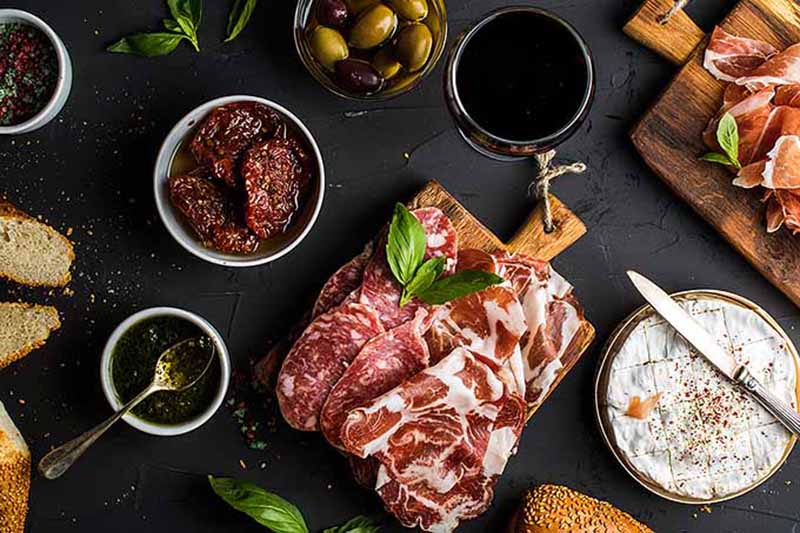
Cornichons are a popular choice, or try something unexpected as an alternative to the usual cucumber, like pickled carrots, onions, green beans, grapes, or squash. A selection of olives of different sizes, shapes, and colors is always welcome in a cheese and charcuterie spread as well.
Try our recipe for garlic and herb roasted olives for an ideal savory accoutrement.
Classic Sampler Collection, available from Stonewall Kitchen
Mustard could also be served to pair with some of your selections, especially the meats. There’s nothing quite like the salty, slightly bitter and tart bite of a good mustard with a little ham on bread.
Vessels for Eating
You absolutely must offer bread, crackers, crostini, or some other plain base to accompany your dairy selections. If you serve a warmed camembert, how will you eat it if you don’t have a vessel for getting it to your mouth?
Carr’s Entertainment Cracker Collection, available on Amazon
You don’t want anything herbed or peppery because you don’t need to add a competing flavor in your mouth. I really like serving an assortment of simple crackers like this collection from Carr’s, available on Amazon, with my hard cheeses like Manchego, cheddar, or gouda.
For my soft or creamy options I like to offer a crusty bread or crostini to spread them on. If you, like me, love a good cheese ball, choose a sturdier cracker.
4. Drink Choices Really Make It Special
Now that you have your food situation all figured out, it’s time to talk beverages. Everyone knows that cheese and wine make the perfect pair, but which wines should you serve?
Wine Rules
There are two paths that you could follow here, when you’re trying to find the best wine to serve. First, you can serve wines that complement your edibles, like a bold wine to go with strong-flavored cheeses and meats.

Alternatively, you can choose wines that provide a nice contrast to the food, like serving a light, more acidic wine to cut the sweetness of your brie with preserves, or offering a fruity red to mellow out the sharpness of your cheddar.
Both of these ideas work well, so it’s really just a matter of personal preference. You might want to have a solo tasting party to find out what you like together, or just offer several wine options to your guests.
There are two rules that I like to follow:
1. Pair Mellow with Mild
The first is to pair mellow wine with a mild cheese. I don’t want a strong drink to overpower the taste of the food I’m eating.
2. Stay Regional
My second rule of thumb is to try to serve wine from the same region from whence my cheese originates.
If I have Manchego on my board, I will probably have a rioja in my glass. Likewise, an Italian prosecco’s bubbles will nicely cut through the saltiness of Parmigiano Reggiano.
There are several other combinations that are traditionally served together. If you’re new at pairing wine with food, you can always just stick with the following perennial favorites, and you really can’t go wrong.
Traditional Pairings
Port is a rich, sweet wine, typically served with a dessert course. Its sweetness cuts the tanginess of blue cheese wonderfully, so it makes a nice contrast.
A full-bodied cabernet sauvignon like this one from Naked Wines goes really well with gouda, cheddar, and other strongly-flavored hard cheeses. Neither one overpowers the other, so there’s a nice balance.
Camille Benitah Maxville Lake Winery Napa Valley Cabernet Sauvignon 2015, available from Naked Wines
Chardonnay is paired with Gruyere quite often. Most chardonnays have fruit and nut undertones that go so well with a nutty Gruyere.
The light, bright flavor of Champagne is wonderful with your creamy, soft cheeses. That bubbly burst in your mouth creates a nice balance with the mellow sweetness of Brie or camembert.
Cheddar is always good with a full-bodied red. I like merlot, cabernet sauvignon, or even a shiraz with my cheddar.
Really, the combinations here are endless. Though most of my friends and relatives aren’t hardcore wine enthusiasts, many are familiar with at least a few varieties that they know and love.
Offering a little bit of everything is a great way to explore new wines, and to satisfy the tastes of your guests. A selection like the ones available from Wine Insiders Club can simplify the process of choosing your bottles.
Wine Insiders Club Subscription Service
All red, all white, or mixed cases are available for shipment approximately every 12 weeks, plus bonus winter and summer shipments. And it’s easy to change your wine preferences or skip a shipment if you need to.
If you fall into this category, then you can always just start from the wine and work backwards. Pick out the wines you know you like to drink and then think about their flavor profiles and how they would taste with certain cheeses, using the tips outlined above for guidance.
From there, head to the cheese department at your local market. Here’s where it’s really helpful to choose a high-end market that will be sure to have informed employees who can help you make good matches.
Other Beverage Choices
While wine may be the drink most associated with these types of foods, it is by no means that only refreshment you can serve.
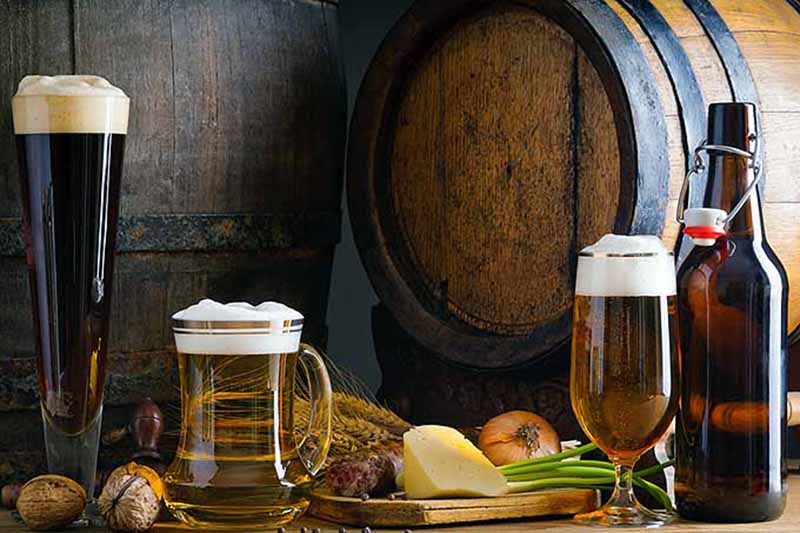
If you’re more a fan of beer than wine, have no fear! Beer goes great with cheese and lots of other foods. Take a look at this article on German beer pairings or this more general post on beer and food pairings for inspiration.
Some of my favorites are stout with aged Irish cheddar, and nutty gouda with my Sam Adams Oktoberfest.
Cocktails are always yummy, too. A dry martini, Manhattan, gin and tonic, or mojitos all go surprisingly well with most types of queso, so don’t be afraid to pull out the liquor.
I would steer clear of the really sweet, fruity cocktails, though. That’s not a flavor that works wells with most of the other tastes you’ll have available.
Sparkling water, plain or flavored with lemon or lime juice, is a good option for non-drinkers. You can also offer apple juice, cut with club soda to minimize the sweetness, as apple goes so well with most anything.
Review our roundup of non-alcoholic beverages for other choices!
5. How to Serve
The final step to pulling this off is to have the right serving equipment, and glassware for the beverages.
Italian Olivewood Serving Board, available from Sur La Table
For my fromage selection, I like to use this large, rustic olivewood serving board from Sur La Table. Because of the natural shape of the wood, the size will vary slightly, but it will be roughly 17 inches by 7 inches.
I definitely recommend finding a way to label everything, so your guests can know exactly what they are eating with no guesswork involved.

Metal Mini Chalkboards, available on Amazon
Mini chalkboards like these, available from Amazon, are great because they’re reusable.
Cheese knives are another must. You need a sharper knife for cutting the hard selection, and something rounded for cutting and spreading softer choices. Be sure to put out a separate knife for each offering, so the flavors don’t get mixed up.

5-piece Stainless Steel Cheese Knives Set, available on Amazon
Make sure your meats are already cut or sliced, and serve them artfully arranged on the tray or platter with a separate serving fork for each.
Any fruit served should also be washed, sliced, and ready to go. Have mini tongs or forks available to pick up each option.
Offer nuts, pickles, and condiments like chutney or mustard in separate dishes, each with their own little spoon or fork for serving.
If the guests will be getting their own drinks, set up a bar area with all of the beverage choices grouped together with the appropriate glasses for beer or for wine. Set out a stack of plates, a stack of napkins, and you’ll be good to go!
Now You’re Ready to Entertain!
You’ve made all your selections, the food is artfully arranged, and your wine is ready to pour. Let the entertaining begin!

If you follow these five steps, it really is so very easy to lay out an impressive spread that looks amazing, and tastes just as good.
What are some of your favorite ways to host your friends and family? Let us know in the comments below!
Don’t stop the party now! For more helpful and tasty tips on planning the best parties, read more of our informational articles next:
- 9 Tips for Cooking in Bulk for a Large Dinner Party
- Tips for Planning a Wine Party
- How to Purchase and Cook Prime Rib
© Ask the Experts, LLC. ALL RIGHTS RESERVED. See our TOS for more details. Product photos courtesy of Amazon, Mouth, Stonewall Kitchen, Naked Wines, Wine Insiders, and Sur La Table. Uncredited photos via Shutterstock. Originally published on December 10, 2016. Last updated on January 17, 2023. With additional writing and editing by Allison Sidhu and Nikki Cervone.
About Ashley Martell
Ashley has enjoyed creative writing since she was six years old, when she wrote her first short story. She majored in English literature at the University of Montevallo. After years of professional work, she is now a stay-at-home mom of three, who uses her craft to write about her life and adventures in and out of the kitchen.


